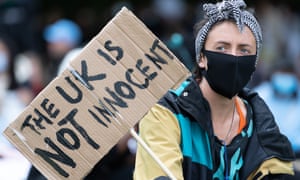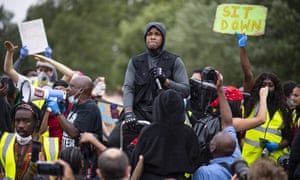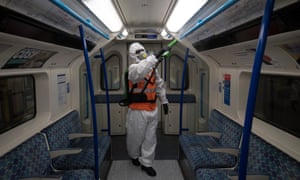
‘Less than two weeks ago, the enlightened position was to exercise extreme caution. Many of us went further, taking to social media to shame others for insufficient social distancing.’ Photograph: Devon Ravine/AP
When I reflect back on the extraordinary year of 2020 – from, I hope, some safer, saner vantage – one of the two defining images in my mind will be the surreal figure of the Grim Reaper stalking the blazing Florida shoreline, scythe in hand, warning the sunbathing masses of imminent death and granting interviews to reporters. The other will be a prostrate George Floyd, whose excruciating Memorial Day execution sparked a global protest movement against racism and police violence.
Less than two weeks after Floyd’s killing, the American death toll from the novel coronavirus has surpassed 100,000. Rates of infection, domestically and worldwide, are rising. But one of the few things it seems possible to say without qualification is that the country has indeed reopened. For 13 days straight, in cities across the nation, tens of thousands of men and women have massed in tight-knit proximity, with and without personal protective equipment, often clashing with armed forces, chanting, singing and inevitably increasing the chances of the spread of contagion.
Scenes of outright pandemonium unfold daily. Anyone claiming to have a precise understanding of what is happening, and what the likely risks and consequences may be, should be regarded with the utmost skepticism. We are all living in a techno-dystopian fantasy, the internet-connected portals we rely on rendering the world in all its granular detail and absurdity like Borges’s Aleph. Yet we know very little about what it is we are watching.
I open my laptop and glimpse a rider on horseback galloping through the Chicago streets like Ras the Destroyer in Ralph Ellison’s Invisible Man; I scroll down further and find myself in Los Angeles, as the professional basketball star JR Smith pummels a scrawny anarchist who smashed his car window. I keep going and encounter a mixed group of business owners in Van Nuys risking their lives to defend their businesses from rampaging looters; the black community members trying to help them are swiftly rounded up by police officers who mistake them for the criminals. In Buffalo, a 75-year-old white man approaches a police phalanx and is immediately thrown to the pavement; blood spills from his ear as the police continue to march over him. Looming behind all of this chaos is a reality-TV president giddily tweeting exhortations to mass murder, only venturing out of his bunker to teargas peaceful protesters and stage propaganda pictures.
George Floyd wasn’t merely killed for being black – he was also killed for being poor
But this virus – for which we may never even find a vaccine – knows and respects none of this socio-political context. Its killing trajectory isn’t rational, emotional, or ethical – only mathematical. And just as two plus two is four, when a flood comes, low-lying areas get hit the hardest. Relatively poor, densely clustered populations with underlying conditions suffer disproportionately in any environment in which Covid-19 flourishes. Since the virus made landfall in the US, it has killed at least 20,000 black Americans.
After two and a half months of death, confinement, and unemployment figures dwarfing even the Great Depression, we have now entered the stage of competing urgencies where there are zero perfect options. Police brutality is a different if metaphorical epidemic in an America slouching toward authoritarianism. Catalyzed by the spectacle of Floyd’s reprehensible death, it is clear that the emergency in Minneapolis passes my own and many peoples’ threshold for justifying the risk of contagion.
But poverty is also a public health crisis. George Floyd wasn’t merely killed for being black – he was also killed for being poor. He died over a counterfeit banknote. Poverty destroys Americans every day by means of confrontations with the law, disease, pollution, violence and despair. Yet even as the coronavirus lockdown threw 40 million Americans out of work – including Floyd himself – many progressives accepted this calamity, sometimes with stunning blitheness, as the necessary cost of guarding against Covid-19.
The new, “correct” narrative about public health – that one kind of crisis has superseded the other – grows shakier as it spans out from Minnesota, across America to as far as London, Amsterdam and Paris – cities that have in recent days seen extraordinary manifestations of public solidarity against both American and local racism, with protesters in the many thousands flooding public spaces.
Consider France, where I live. The country has only just begun reopening after two solid months of one of the world’s severest national quarantines, and in the face of the world’s fifth-highest coronavirus body count. As recently as 11 May, it was mandatory here to carry a fully executed state-administered permission slip on one’s person in order to legally exercise or go shopping. The country has only just begun to flatten the curve of deaths – nearly 30,000 and counting – which have brought its economy to a standstill. Yet even here, in the time it takes to upload a black square to your Instagram profile, those of us who move in progressive circles now find ourselves under significant moral pressure to understand that social distancing is an issue of merely secondary importance.
This feels like gaslighting. Less than two weeks ago, the enlightened position in both Europe and America was to exercise nothing less than extreme caution. Many of us went much further, taking to social media to castigate others for insufficient social distancing or neglecting to wear masks or daring to believe they could maintain some semblance of a normal life during coronavirus. At the end of April, when the state of Georgia moved to end its lockdown, the Atlantic ran an article with the headline “Georgia’s Experiment in Human Sacrifice”. Two weeks ago we shamed people for being in the street; today we shame them for not being in the street.
As a result of lockdowns and quarantines, many millions of people around the world have lost their jobs, depleted their savings, missed funerals of loved ones, postponed cancer screenings and generally put their lives on hold for the indefinite future. They accepted these sacrifices as awful but necessary when confronted by an otherwise unstoppable virus. Was this or wasn’t this all an exercise in futility?
“The risks of congregating during a global pandemic shouldn’t keep people from protesting racism,” NPR suddenly tells us, citing a letter signed by dozens of American public health and disease experts. “White supremacy is a lethal public health issue that predates and contributes to Covid-19,” the letter said. One epidemiologist has gone even further, arguing that the public health risks of not protesting for an end to systemic racism “greatly exceed the harms of the virus”.
The climate-change-denying right is often ridiculed, correctly, for politicizing science. Yet the way the public health narrative around coronavirus has reversed itself overnight seems an awful lot like … politicizing science.
What are we to make of such whiplash-inducing messaging? Merely pointing out the inconsistency in such a polarized landscape feels like an act of heresy. But “‘Your gatherings are a threat, mine aren’t,’ is fundamentally illogical, no matter who says it or for what reason,” as the author of The Death of Expertise, Tom Nichols, put it. “We’ve been told for months to stay as isolated as humanely possible,” Suzy Khimm, an NBC reporter covering Covid-19, noted, but “some of the same public officials and epidemiologists are [now] saying it’s OK to go to mass gatherings – but only certain ones.”
Public health experts – as well as many mainstream commentators, plenty of whom in the beginning of the pandemic were already incoherent about the importance of face masks and stay-at-home orders – have hemorrhaged credibility and authority. This is not merely a short-term problem; it will constitute a crisis of trust going forward, when it may be all the more urgent to convince skeptical masses to submit to an unproven vaccine or to another round of crushing stay-at-home orders. Will anyone still listen?
Seventy years ago Camus showed us that the human condition itself amounts to a plague-like emergency – we are only ever managing our losses, striving for dignity in the process. Risk and safety are relative notions and never strictly objective. However, there is one inconvenient truth that cannot be disputed: more black Americans have been killed by three months of coronavirus than the number who have been killed by cops and vigilantes since the turn of the millennium. We may or may not be willing to accept that brutal calculus, but we are obligated, at the very least, to be honest.
When I reflect back on the extraordinary year of 2020 – from, I hope, some safer, saner vantage – one of the two defining images in my mind will be the surreal figure of the Grim Reaper stalking the blazing Florida shoreline, scythe in hand, warning the sunbathing masses of imminent death and granting interviews to reporters. The other will be a prostrate George Floyd, whose excruciating Memorial Day execution sparked a global protest movement against racism and police violence.
Less than two weeks after Floyd’s killing, the American death toll from the novel coronavirus has surpassed 100,000. Rates of infection, domestically and worldwide, are rising. But one of the few things it seems possible to say without qualification is that the country has indeed reopened. For 13 days straight, in cities across the nation, tens of thousands of men and women have massed in tight-knit proximity, with and without personal protective equipment, often clashing with armed forces, chanting, singing and inevitably increasing the chances of the spread of contagion.
Scenes of outright pandemonium unfold daily. Anyone claiming to have a precise understanding of what is happening, and what the likely risks and consequences may be, should be regarded with the utmost skepticism. We are all living in a techno-dystopian fantasy, the internet-connected portals we rely on rendering the world in all its granular detail and absurdity like Borges’s Aleph. Yet we know very little about what it is we are watching.
I open my laptop and glimpse a rider on horseback galloping through the Chicago streets like Ras the Destroyer in Ralph Ellison’s Invisible Man; I scroll down further and find myself in Los Angeles, as the professional basketball star JR Smith pummels a scrawny anarchist who smashed his car window. I keep going and encounter a mixed group of business owners in Van Nuys risking their lives to defend their businesses from rampaging looters; the black community members trying to help them are swiftly rounded up by police officers who mistake them for the criminals. In Buffalo, a 75-year-old white man approaches a police phalanx and is immediately thrown to the pavement; blood spills from his ear as the police continue to march over him. Looming behind all of this chaos is a reality-TV president giddily tweeting exhortations to mass murder, only venturing out of his bunker to teargas peaceful protesters and stage propaganda pictures.
George Floyd wasn’t merely killed for being black – he was also killed for being poor
But this virus – for which we may never even find a vaccine – knows and respects none of this socio-political context. Its killing trajectory isn’t rational, emotional, or ethical – only mathematical. And just as two plus two is four, when a flood comes, low-lying areas get hit the hardest. Relatively poor, densely clustered populations with underlying conditions suffer disproportionately in any environment in which Covid-19 flourishes. Since the virus made landfall in the US, it has killed at least 20,000 black Americans.
After two and a half months of death, confinement, and unemployment figures dwarfing even the Great Depression, we have now entered the stage of competing urgencies where there are zero perfect options. Police brutality is a different if metaphorical epidemic in an America slouching toward authoritarianism. Catalyzed by the spectacle of Floyd’s reprehensible death, it is clear that the emergency in Minneapolis passes my own and many peoples’ threshold for justifying the risk of contagion.
But poverty is also a public health crisis. George Floyd wasn’t merely killed for being black – he was also killed for being poor. He died over a counterfeit banknote. Poverty destroys Americans every day by means of confrontations with the law, disease, pollution, violence and despair. Yet even as the coronavirus lockdown threw 40 million Americans out of work – including Floyd himself – many progressives accepted this calamity, sometimes with stunning blitheness, as the necessary cost of guarding against Covid-19.
The new, “correct” narrative about public health – that one kind of crisis has superseded the other – grows shakier as it spans out from Minnesota, across America to as far as London, Amsterdam and Paris – cities that have in recent days seen extraordinary manifestations of public solidarity against both American and local racism, with protesters in the many thousands flooding public spaces.
Consider France, where I live. The country has only just begun reopening after two solid months of one of the world’s severest national quarantines, and in the face of the world’s fifth-highest coronavirus body count. As recently as 11 May, it was mandatory here to carry a fully executed state-administered permission slip on one’s person in order to legally exercise or go shopping. The country has only just begun to flatten the curve of deaths – nearly 30,000 and counting – which have brought its economy to a standstill. Yet even here, in the time it takes to upload a black square to your Instagram profile, those of us who move in progressive circles now find ourselves under significant moral pressure to understand that social distancing is an issue of merely secondary importance.
This feels like gaslighting. Less than two weeks ago, the enlightened position in both Europe and America was to exercise nothing less than extreme caution. Many of us went much further, taking to social media to castigate others for insufficient social distancing or neglecting to wear masks or daring to believe they could maintain some semblance of a normal life during coronavirus. At the end of April, when the state of Georgia moved to end its lockdown, the Atlantic ran an article with the headline “Georgia’s Experiment in Human Sacrifice”. Two weeks ago we shamed people for being in the street; today we shame them for not being in the street.
As a result of lockdowns and quarantines, many millions of people around the world have lost their jobs, depleted their savings, missed funerals of loved ones, postponed cancer screenings and generally put their lives on hold for the indefinite future. They accepted these sacrifices as awful but necessary when confronted by an otherwise unstoppable virus. Was this or wasn’t this all an exercise in futility?
“The risks of congregating during a global pandemic shouldn’t keep people from protesting racism,” NPR suddenly tells us, citing a letter signed by dozens of American public health and disease experts. “White supremacy is a lethal public health issue that predates and contributes to Covid-19,” the letter said. One epidemiologist has gone even further, arguing that the public health risks of not protesting for an end to systemic racism “greatly exceed the harms of the virus”.
The climate-change-denying right is often ridiculed, correctly, for politicizing science. Yet the way the public health narrative around coronavirus has reversed itself overnight seems an awful lot like … politicizing science.
What are we to make of such whiplash-inducing messaging? Merely pointing out the inconsistency in such a polarized landscape feels like an act of heresy. But “‘Your gatherings are a threat, mine aren’t,’ is fundamentally illogical, no matter who says it or for what reason,” as the author of The Death of Expertise, Tom Nichols, put it. “We’ve been told for months to stay as isolated as humanely possible,” Suzy Khimm, an NBC reporter covering Covid-19, noted, but “some of the same public officials and epidemiologists are [now] saying it’s OK to go to mass gatherings – but only certain ones.”
Public health experts – as well as many mainstream commentators, plenty of whom in the beginning of the pandemic were already incoherent about the importance of face masks and stay-at-home orders – have hemorrhaged credibility and authority. This is not merely a short-term problem; it will constitute a crisis of trust going forward, when it may be all the more urgent to convince skeptical masses to submit to an unproven vaccine or to another round of crushing stay-at-home orders. Will anyone still listen?
Seventy years ago Camus showed us that the human condition itself amounts to a plague-like emergency – we are only ever managing our losses, striving for dignity in the process. Risk and safety are relative notions and never strictly objective. However, there is one inconvenient truth that cannot be disputed: more black Americans have been killed by three months of coronavirus than the number who have been killed by cops and vigilantes since the turn of the millennium. We may or may not be willing to accept that brutal calculus, but we are obligated, at the very least, to be honest.




